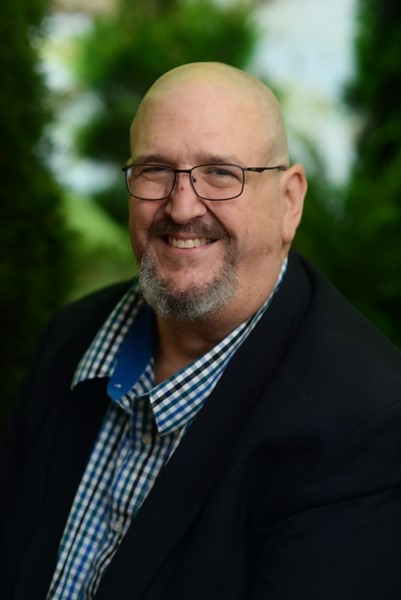
“All of a sudden, I just had a crushing chest pain.”
David Noe, who had spent large portions of his own life as an emergency responder, knew immediately that his sudden-onset symptoms on a Sunday afternoon weren’t a heart attack.
On his way to the hospital by ambulance and coming in and out of consciousness, Noe was able to tell first responders to stop giving him nitroglycerin: he knew he was having an aortic dissection.
“This is not an MI. I have Marfans. I’m dissecting,” said Noe.
Living with Marfan syndrome
Noe, who stands 6 foot 8 inches tall and has many classic features of Marfan syndrome, grew up in Cincinnati and was diagnosed with the condition around age 12.
“I was originally diagnosed on a preliminary basis by my family doctor, who had read a few articles in the journals about Marfans. He wasn’t really sure if I had it, but he figured there was a pretty good chance,” said Noe.
While a student at the University of Maryland, Noe was advised to go to nearby Johns Hopkins, where he was formally diagnosed and treated by legendary Marfan syndrome pioneering physician Dr. Reed Pyeritz. Noe stuck closely to a regimen of medical monitoring that included annual echoes.
As life and career took him to California, he continued to get echoes. But then, a local doctor erroneously told him he had “passed the age of danger” for Marfan syndrome-related dissection and advised he no longer needed his beta blockers nor close monitoring.
An ordinary Sunday changed everything
Flash forward two years to the day Noe dissected in 2002.
Noe’s family, which included his wife Stephanie and two young children, Samantha and Dominga, had been getting ready for a weeklong trip to Disneyland when his dissection happened. He was in his office on a Sunday afternoon, catching up on work when symptoms began. Noe, who was within feet of a local firehouse down the street where he knew personnel on site, managed to get there to seek help.
“There’s a thought in emergency response that If the patient looks bad, he’s probably really bad,” said Noe. “The fire captain at the station told me later, ‘Well, you looked dead’ when I walked into the fire station.”
First responders, upon seeing Noe, reacted “like rockets” and brought him to the local hospital. By the time Noe arrived, his condition was grim.
Prior to surgery, his prognosis was so poor that doctors advised Noe’s family to come and say goodbye.
“I remember hearing them say that…I remember hearing the girls and trying to hug them,” said Noe. Noe also remembers hearing his wife discuss with doctors his end-of-life wishes if recovery wasn’t in the cards.
In a piece of amazing luck, a surgeon from the Mayo Clinic was working on-site and was able to surgically save Noe’s life. According to Noe, during surgery, physicians “replaced [his aorta] from just above the valve all the way over to the ascending arch and a little bit down the other side. That went fairly well.”
Following one post-surgical complication, Noe’s next memory is waking up in a step-down room.
“Trying to figure out why everything hurt when I moved,” said Noe. His more than three months of recovery wasn’t easy, but Noe came through it and returned to his work and life.
“I most definitely know that I got lucky,” said Noe.
Understanding Marfan as a family
Now, David and his family’s attention turned to learning whether his children had Marfan syndrome as well.
Ultimately, under the care of Dr. David Liang, he learned his daughters also had Marfan. Both have had preventative surgery in order to hopefully avoid the type of emergency dissection David Noe had experienced.
Still, knowing he genetically passed down Marfan syndrome to his children has been emotionally challenging for Noe. “I had a lot of problems with guilt when they were diagnosed and when they each had their surgeries. I don’t wish that on anybody,” said Noe – who is equally grateful that his daughters have been able to shore up their aortic health in safer, non-emergent settings.
Noe is also grateful that he has gotten to enjoy milestones with his family he would have missed had he not survived his dissection many years ago.
“It actually means a great deal,” said Noe.
Noe credits the Marfan Foundation for providing support through events like the annual Conference, which have been invaluable to his family and himself. Noe’s daughter, Dominga, who David Noe says always looked forward to Conference as a teen, now serves on the Marfan staff team in the IT department and leads the Foundation’s teen program with events such as Teen Game Night and Teen Talk for young people in the genetic aortic and vascular conditions community.
Life-saving, life-affirming advice
Noe has two primary pieces of advice for others living with genetic aortic and vascular conditions who are at increased risk of aortic dissection: be a self-advocate and be willing to educate others.
“You have to stand up for your rights,” said Noe. “If a patient is self-advocating [doctors] can’t just ignore them…all too often [non-expert medical providers] do.” When it comes to rare conditions, many doctors “know about them but know very little about them,” said Noe. “Critically important rapid diagnosis time improves when patients with Marfan, Loeys-Dietz, VEDS, and related conditions or their family advocates are heard, according to Noe.
Noe, who has worked with Dr. Liang and others to provide CME training and other educational opportunities to non-expert providers, believes being willing to teach others, including medical professionals, about genetic aortic and vascular conditions is essential. He advises anyone trying to cope following dissection survival to both find support and pay forward lessons learned.
“Learn as much as you can. Get involved in your local community group as well as the Foundation’s annual Conference, You will get the opportunity to see a lot of people who are in the same boat as you who have lived long lives,” said Noe.
“I always try to find a newbie [at Marfan/dissection-related community events] that I can take under my wing and help them answer questions that they may be afraid to ask in a group. Having that support network, whether formal or informal, is critical,” said Noe.

The Marfan Foundation is a nonprofit organization that saves lives and improves the quality of life of individuals with genetic aortic and vascular conditions including Marfan, Loeys-Dietz, and Vascular Ehlers-Danlos syndromes. Our vision is a world in which everyone with genetic aortic and vascular conditions can live their best life.
